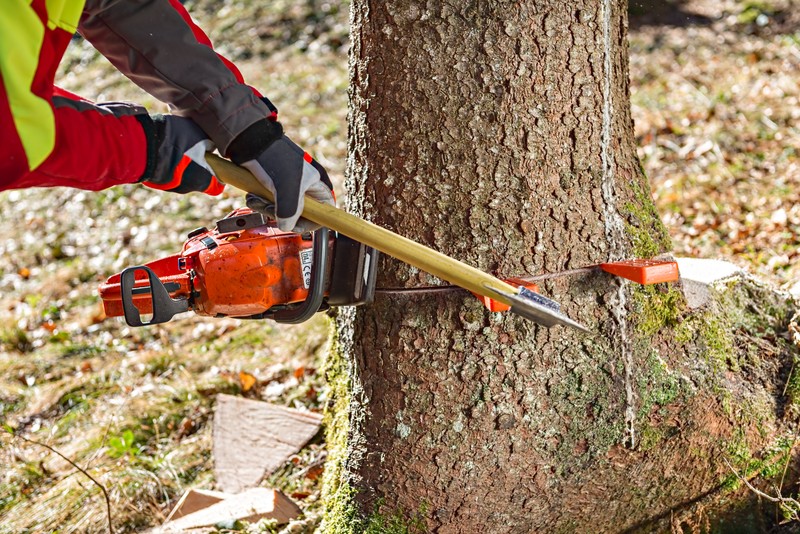The last thing you want to happen when you're just trying to save a couple of bucks on a tree service is having the tree you are sawing decide to fall onto that truck you just finished paying off. To learn how to avoid this, read the article below.
Think about safety first and the prevention of accidents when preparing to fell a tree. Look at where the tree is located and what objects are around it. Houses, barns, power lines, fences and other structures can be damaged due to falling trees or limbs. If there are roads located within the fall zone, set up warning signs.
Pay special attention to other trees as well. Making a tree fall can have a domino effect on other trees that may be smaller or weakened by tree rot and leaning. Even if you do not think the tree you are planning to cut down will strike an object, a tree that is hit by the tree you cut down could fall in an unexpected way, so it is best to imagine all possible scenarios before cutting.Decide What Direction to Fell a Tree
Once you have a good idea of surrounding objects, look at the tree itself to figure out what direction in which to fell the tree. If the tree is naturally leaning in one direction, it may be better to fell the tree that way as long as there are no objects within the fall zone. If there are objects in the fall zone and the tree is leaning in that direction, you may want to get an experienced tree service to come and remove the tree professionally. Wind speed can also effect directional felling. Finally, consider the work involved in removing the tree once it has fallen and how easy or difficult it will be for you to access the area in the fall zone.
Directional Felling: How to Fell a Tree in the Right Direction
Follow these steps to make an open directional notch in a small-to-medium sized tree using a chainsaw:
Pinpoint the exact direction in which you want the tree to fall. Find a landmark from your surroundings to use as a guide, and use the sights on the top of your chainsaw to line up the angle to the directional notch you plan to cut.
Make a top cut into the trunk of the tree at about a 60 degree angle, sawing to a depth of about 20 – 25% of the tree's diameter.
Make a horizontal undercut that meets the top cut. You should now have a notch carved out of the side of the tree facing the felling direction.
Make sure there are no people or animals within the safety radius of the tree felling zone. This is at least 2 times the length of the tree you are felling.
On the opposite side of the tree trunk, saw a horizontal felling cut a few inches above the level of the undercut. Stop cutting a few inches before you reach the directional notch. This will create a hinge on which the tree will fall in a controlled way. The width of the hinge should be about 10% of the diameter of the tree trunk.
Use a felling wedge as a lever to make the tree begin to fall. You may need to hammer the felling wedge into place. Sometimes more than one wedge is required. Use a breaker bar to work the tree until it begins to fall.
Watch and retreat. Keep your eyes on the falling tree as you move away quickly but calmly. You should try to move away from the felling direction at a 90 degree angle. This will help you avoid both the felling zone as well as the opposite side where the trunk separates from the stump.
Keep your eyes on the falling tree as you move away quickly but calmly out of the safety zone. You should try to move away from the felling direction at a 90 degree angle. This will help you avoid both the felling zone as well as the opposite side where the trunk separates from the stump.
Of course, the best way to avoid the utter stress of potentially collapsing a ten-ton tree through your living room is simply calling a professional that does this kind of work on a daily basis. But you didn't get to where you are by calling for help on every problem.
Figuring it out yourself is always more satisfying anyways. Just be sure to remember to take into account wind speed, the angle of the tree, and the height; all of these things will play a heavy role in how the tree will fall towards the ground. Good luck!
If you would like to learn more about this subject, take a look at the rest of the article at Tractor Supply.

Up next; How to cut a string with a knife!
How to butter your bread, up next after learning to tie your shoes
How to shoot a gun using bullets
How to build a house using nails
How to drive a nail using a hammer
How to drink water using a glass!
Rudi
How to wipe your$#%&!@*using toilet paper
Cool